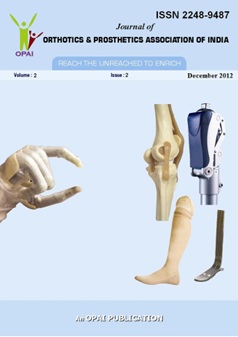Journal of Orthotics & Prosthetics Association of India (JOPAI) – Submission Guidelines and Policies
Journal of Orthotics and Prosthetics Association of India is the only ISSN serial bi-annual National Journal in the field of Prosthetics and Orthotics published in India. Orthotics and Prosthetics Association of India started the publication of the Journal in the year 2011. No tariff is charged for submission, processing or publication of manuscripts and even for colour reproduction of photographs. The Journal will cover technical, clinical and bioengineering studies related to Prosthetics and Orthotics including ethical and social issues. It aims to provide clinically relevant evidence, foster professional development, and enhance the quality of care for individuals needing prosthetic, orthotic, and rehabilitative services.

The journal caters to a diverse, multidisciplinary, and global readership. The Journal would publish peer-reviewed original research, case studies, technical briefs, reviews, clinical directives, editorials, and correspondence. Manuscripts should align with the journal’s scope and aims, adhere to formatting guidelines, and demonstrate originality, clarity, and methodological rigor. The article submitted should neither have been published previously (except proceedings of a conference, congress or seminar), nor they should have been submitted for publication elsewhere simultaneously.
Scope of the Journal:
JOPAI covers a broad spectrum of topics in prosthetic and orthotic field including:
• Clinical methodologies and interventions
• Innovations in rehabilitative technology
• Retrospective analysis of clinical datasets
• Evaluation of health-related quality of life metrics and user feedback
• Educational strategies and outcomes
• Development and refinement of measurement tools
Readership:
Our audience includes a diverse, multidisciplinary, and global group of professionals such as:
• Prosthetists
• Orthotists
• Physical therapists
• Occupational therapists
• Physical medicine and rehabilitation physicians
• Orthopaedic surgeons
• Biomedical engineers
Types of Articles Accepted:
• Original research (experimental, observational, qualitative, educational studies)
• Case studies
• Technical briefs
• Narrative and systematic reviews
• Clinical guidelines
• Editorials
• Correspondence to the editor
Peer Review
All the articles submitted to the Journal are subjected to be reviewed by experts. The reviewers are chosen from India and may be from the members in the council of Editors. The names of the council of editors will be published in each issue of the Journal.
Before review, the Editorial Board will assess manuscripts based on the following criteria:
1. Scope of the Journal: Ensure alignment with the journal’s aims and scope.
2. Adherence to Instructions: Confirm adherence to formatting and submission guidelines.
3. Originality and Objectives: Assess novelty and clarity of research objectives.
4. Theoretical Basis and Literature Review: Evaluate the theoretical framework and literature review’s adequacy and currency.
5. Methodological Rigor: Review the consistency, accuracy, and appropriateness of the methodology.
6. Results Quality: Evaluate the significance and quality of results.
7. Discussion Depth: Assess how well the findings are discussed in relation to existing literature.
8. Tables and Figures: Check the clarity and relevance of tables and figures.
9. Conclusions: Ensure originality and logical consistency of conclusions.
10. Relevance Criterion: Prioritize papers with significant contributions if manuscript volume exceeds publication capacity.
11. Quality Control: Verify that accepted manuscripts meet quality standards.
12. Reviewer Selection: Choose reviewers based on expertise relevant to the manuscript content.
13. Feedback to Authors: Provide constructive feedback for improvement or clarification.
14. Timely Handling: Ensure efficient processing of manuscripts to meet publication deadlines.
General Guidelines: –
1. Correspondence relating to the Journal of Orthotics and Prosthetics Association of India may please be addressed to: Aratatran Patra, Editor, JOPAI, 70,Bidhan Park, Flat No.9, Third Floor, Kolkata-700090 and Email:journal@opai.org.in , Ph. 8777636264.
2. The manuscripts for the JOPAI should be submitted in online in MS Word format only. The last date of Submission will be notified time to time. The file size should not exceed 5MB.
3. Each of the authors confirms his participation in the study concerned and approves the content, as well as a clear-cut affirmation that the article is an original work and has not been published/submitted for publication elsewhere (except Conferences, Seminars and in any congress) and will not be so submitted, if accepted for publication in the JOPAI. A certificate to this effect should accompany in each article with scan copy followed by hard copy.
4. It is understood and accepted that the submitted matter would be editorially revised to make it suitable for publication. The decision of the members in council of Editors regarding acceptance or revision cannot be contested. However, every effort is made to communicate the reason or deficiencies to the corresponding author in order to associate him with the steps to improve the article.
5. All the received articles are serially registered and usually published in the order of registration. However, registration will be done after the completion of the basic formalities; the registered articles are reviewed by the reviewers to judge suitability for publication and to give suggestions for improvement.
6. One reprint of each published article is supplied free of cost to the author whose address in indicated for correspondence. More reprints are supplied if the order is placed at the time of acceptance of the article. The cost of additional reprints must be paid for in advance of the publication.
Structure of the Paper
All submitted articles shall have a definite format comprising the following:
1. Title, Authorship, and Institutional Information:
o Title: Maximum 15 words, bold, with only the first letter capitalized.
o Authors’ Names: Full names with initial letters in uppercase, separated by commas, and the last two names joined by “and,” followed by Arabic numerals for affiliations.
o Authors’ Addresses: Full postal addresses and corresponding email addresses.
o Corresponding Author: Name, email ID, and contact number.
2. Abstract:
o Length: Maximum 500 words.
o Structure: Brief sentences covering objectives, materials and methods, results, and conclusions in the present tense.
o Clinical Relevance: Include a 1-2 sentence summary of the work’s impact on clinical practice.
3. Keywords:
o Minimum of 6 keywords, separated by commas, all lowercase except for the first word.
4. Introduction:
o Heading: Centered, bold, with only the first letter capitalized.
o Length: Up to two pages, providing a clear rationale and connection to existing literature.
5. Materials and Methods:
o Detailed description of location, date, design, treatments, and other experimental specifics.
o Subsections: Objectives, Hypotheses, Participants, Materials, Data Collection, Scoring, Variables.
6. Ethics and Patient Consent
o Research involving human subjects must have clearance from ethical committee.
o Informed consent must be obtained from patients.
7. Results and Discussion:
o Length: Up to four pages.
o Presentation: Tables and figures mentioned consecutively in numerical order.
o Discussion: Compare findings with other studies and avoid unsupported claims.
8. Conclusions:
o Brief sentences in the present tense, aligned with study objectives, presenting new findings.
9. Acknowledgements:
o Heading: Cantered, bold, with only the first letter capitalized.
o Content: Brief acknowledgments starting with “To the” followed by persons or institutions.
10. Permissions:
o Obtain written permission for any previously published material included in the manuscript.
o Provide signed authorization for personal communications and unpublished data.
11. Conflicts of Interest:
o Disclose any conflicts of interest related to the work. If none, state “none declared.” List relevant conflicts on the title page under “Conflicts of Interest.”
12. References:
o Use Vancouver style.
o List sources alphabetically by author’s last name, including author initials, article title, abbreviated journal name, volume, issue, page range, and publication year.
Submission Categories, Word Limits, and Reporting Guidelines
Submission Categories:
• Original Research Article: Includes original research findings with information on relevance, literature review, methods, results, and conclusions.
• Review Article: Critical review and summary of current topics and trends.
• Clinical Practice Guidelines (CPGs): Systematic statements for optimizing care.
• Case Report: Detailed discussion of a case study or series, including diagnosis, treatment, and outcomes.
• Technical Note: Reports on specific prosthetic or orthotic procedures and technical solutions.
• Editorials: Opinions or discussions on current issues, usually solicited.
• Letters to the Editor: Observations, criticisms, or responses to articles.
Word Limits:
• Original Research Article: 3,000 words
• Review Article: 5,000 words
• Clinical Practice Guidelines: 5,000 words
• Case Report: 2,000 words
• Technical Note: 1,500 words
• Editorial: 1,000 words
• Letter to the Editor: 500 words
Note: Word limits exclude abstracts, references, table and figure headings, and content within tables and figures.
Format:
• Double spacing
• Times New Roman font with 12 font size
• Margins 2.5 cm from all four sides
• Headings in title case (not ALL CAPITALS)
• Send the article in single file and in MS-Word only.
Language and grammar
• Uniformly American English
• Write the full term for each abbreviation at its first use in the title, abstract, keywords and text separately unless it is a standard unit of measure. Numerals from 1 to 10 spelt out.
• Numerals at the beginning of the sentence spelt out.
• Check the manuscript for spelling, grammar and punctuation errors.
• If a brand name is cited, supply the manufacturer’s name and address (city and state/country).
Tables and figures
• No repetition of data in tables and graphs and in text.
• Actual numbers from which graphs drawn must be provided.
• Figures necessary and should be of good quality (colour).
• Table and figure numbers in Arabic letters (not Roman).
• Figure legends provided (not more than 40 words).
• Patients’ privacy maintained (if not permission taken).
• Credit note for borrowed figures/tables provided.
• Write the full term for each abbreviation used in the table as a footnote.
Publishing Policies
• The journal adheres to publication ethics and takes plagiarism seriously.
• Articles may be checked for duplication.
• Prior publication and simultaneous submission are not allowed.
• Authors must sign a publishing agreement before publication.
• The journal publishes under Creative Commons licenses.
By integrating these guidelines, authors can ensure that their manuscripts meet the journal’s requirements and are prepared for successful submission.
